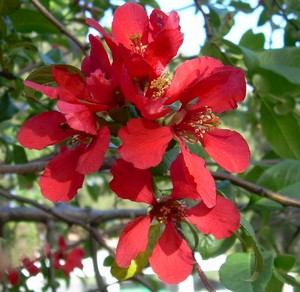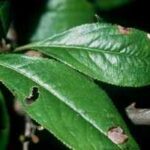One of my favorite old fashioned shrubs is the flowering quince, which belongs to the genus Chaenomoles. This beautiful shrub is native to eastern Asia and produces a hard apple-like fruit.
There are several different species of flowering quince but the most common variety is a hybrid of the C. superba and C. speciosa. This interesting bush reaches a height of 15 feet and can have a 15 foot spread. In the late spring, it produces stunning fiery, red blossoms. Interestingly, the new leaves at the end of branches are also red as they first uncurl, which makes for a beautiful effect.
The flowering quince is disease hardy and doesn’t seem to be affected by frost. It is also low water and heat tolerant, and thrives in a seldom used corner of my yard. My flowering quince is over 90 years old and still continues to produce a bumper crop of fruit.
What can you do with the fruit?
While the quince fruit looks deceptively like an apple, it is completely inedible raw. The only uses we have ever found for the quince fruit was for making jellies or quince butter.
Quince apples are very hard and take a long cooking time to soften. They are prepared by washing thoroughly, peeling, and then quartering. Remove the seeds, then chop the apple into very small pieces. Place the chopped quince apples into a Crock Pot or slow cooker, and cover with water. Allow to cook on low setting overnight, or at least 12 hours.
Preparing the quince for jelly
After the quince has softened up, they can be strained into a kettle. There are many different ways that fruit juice can can be strained; I prefer using a straining bag with a stand. The stand fits directly on top on the kettle and allows the fruit juices to drip directly into the container. For the clearest jelly, allow the quince juice to drip on its own and without squeezing the sack. This process can take a little time.
Once the juice has been extracted, in can be turned into jelly using the long boil method. Because of the high pectin content of quince, it won’t be necessary to add commercial pectin.
How to make quince butter
Another favorite use for the quince fruit is making quince butter. This is done by following the same steps as above. Instead of straining the fruit though, run them through a food mill to turn into applesauce. If you do not have a food mill, a simple method is by running the softened quince through the blender, a cup at a time.
Ingredients:
10 cups processed quince sauce
sugar
cinnamon
cloves
Place 8 cups of the processed quince applesauce in a crock pot, reserving two cups for later. To the crock pot, add 1 cup of sugar. If you like the taste of spiced apple butters, add 1 tsp cinnamon and 1/4 tsp of ground cloves. Stir. Set the crock pot on low and offset the lid slightly. Place towels around the crock pot since the butter can bubble up and splatter.
Apple butter is made by reducing the volume of liquid in the fruit. The longer the cooking time, the thicker the butter. Cooking times can vary between 6-10 hours.
After you have reached the desired consistency, stir in the remaining 2 cups of softened quince, and add more sugar according to your taste. Place the lid on the crock pot and allow the quince butter to cook for an additional 1-2 hours.
If the butter is too thick for your liking, it can be softened by adding a little apple juice. If it is too soft, continue cooking the butter in your crock pot with the lid uncovered, until it reaches the desired texture.




